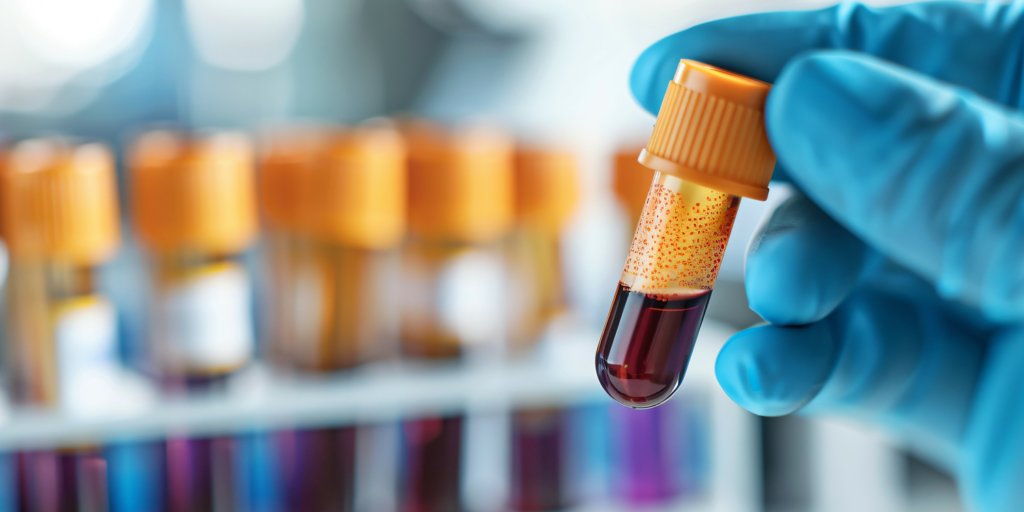Blood Disorders: Types, Symptoms, Causes and Treatments

Blood plays a vital role in overall health by carrying oxygen throughout the body, supporting immune defences, and aiding in healing processes. When there is a problem with any component of blood, whether red cells, white cells, platelets, or plasma, it can lead to a blood disorder. Blood disorders can range from common forms of anaemia to more serious illnesses such as leukaemia or clotting abnormalities. In this article, we have discussed the different types of blood disorders, their symptoms, causes and risk factors, diagnostic methods, and treatment options to help build better awareness and encourage timely medical care.
Table of Contents
ToggleUnderstanding Blood Disorders
Blood is made up of four key components, red blood cells (RBCs), white blood cells (WBCs), platelets, and plasma. Each serves a vital function: RBCs carry oxygen, WBCs fight infections, platelets help with clotting, and plasma transports nutrients, hormones, and waste products.
A blood disorder occurs when any of these components are either too few, too many, or not functioning properly. These imbalances can disrupt oxygen delivery, weaken the immune system, increase the risk of bleeding, or affect clot formation. Some disorders are mild and manageable, while others may be chronic or life-threatening, requiring specialised medical care.
Understanding the basics of how blood works helps in recognising when something may be wrong and when medical evaluation is necessary.
Common Types of Blood Disorders
Blood disorders are generally classified based on which part of the blood is affected. These include conditions involving red blood cells, white blood cells, and platelets, each with its own set of challenges and symptoms.
Red Blood Cell Disorders
Red blood cells carry oxygen to different parts of the body. When there aren’t enough of these cells or they don’t work properly, it can lead to tiredness, weakness, and shortness of breath.
- Anaemia: Anaemia is one of the most common red blood cell problems. It happens when the body doesn’t have enough healthy red blood cells or haemoglobin.
- Iron deficiency anaemia: This is the most frequent type. It often develops due to poor diet, blood loss, or long-term health issues.
- Sickle cell anaemia: This is an inherited condition where red blood cells change shape and can block blood flow, causing pain, tiredness, and can damage organs over time.
White Blood Cell Disorders
White blood cells (WBCs) are essential for protecting the body against infections. When these cells are too few or do not function properly, the immune system becomes weaker.
- Leukaemia (Blood cancer): It is a white blood cell disorder that begins in the bone marrow and leads to the production of large numbers of abnormal white blood cells. These cells are unable to fight infection and crowd out healthy blood cells, making the immune system less effective.
Other white blood cell disorders may result in a low white cell count (leukopenia) or dysfunctional WBCs, both of which make the body more prone to infections and slow recovery.
Platelet and Clotting Disorders
Platelets help the blood form clots to stop bleeding. When there are too few platelets or they don’t work well, it can cause problems with bleeding or bruising.
- Thrombocytopenia: A condition where platelet levels are too low, leading to easy bruising or bleeding.
- Clotting disorders: Such as haemophilia, prevent the blood from clotting properly and can cause long-lasting bleeding after cuts or injuries.
Some people may have the opposite problem, abnormal clotting, which raises the risk of conditions such as deep vein thrombosis or stroke.
Key Symptoms of Blood Disorders
The symptoms of blood disorders can range from mild and easily overlooked to severe and life-altering. They often depend on which part of the blood (red cells, white cells, or platelets) is affected. While some signs may develop gradually, others may require immediate medical attention. Common symptoms to watch for include:
- Fatigue and weakness: Often related to low haemoglobin or anaemia, due to reduced oxygen flow to tissues
- Shortness of breath or rapid heartbeat: Typically linked to red blood cell disorders
- Bruising easily or frequent nosebleeds: May indicate a platelet or clotting disorder
- Recurrent infections or slow healing: Suggests white blood cell dysfunction
- Unexplained bleeding: Such as bleeding gums or heavy menstrual flow
- Pale or yellowish skin: A possible sign of anaemia or red cell breakdown (haemolysis)
- Swollen lymph nodes, bone pain, or unexplained weight loss: Can be symptoms of blood cancers such as leukaemia
When to Seek Medical Attention
While not all symptoms are immediately concerning, it’s important to consult a specialist if they persist, worsen, or interfere with daily life. Timely diagnosis can make a significant difference in treatment and recovery. See a doctor if there is:
- Ongoing fatigue that doesn’t improve with rest
- Frequent or severe infections
- Excessive or unusual bleeding
- Unexplained bruising or small red spots under the skin (petechiae)
- Dizziness, rapid heartbeat, or shortness of breath
- Noticeable paleness or yellowing of the skin (jaundice)
- Swelling in lymph nodes, abdomen, or bones
In children, additional warning signs may include delayed growth, frequent injuries, or constant tiredness. Early medical evaluation by a haematologist can help identify the cause and prevent complications with the right treatment plan.
Causes and Risk Factors
Blood disorders can arise from a wide range of causes, including inherited conditions, nutritional deficiencies, chronic illnesses, and even side effects of medication. Understanding these underlying factors helps in early diagnosis and preventive care.
Genetic and Inherited Conditions
Some blood disorders, such as sickle cell anaemia and haemophilia, are inherited and often diagnosed early in life. These conditions occur due to mutations in specific genes that affect blood cell production or function.
Nutritional Deficiencies
Iron, vitamin B12, and folate are crucial for healthy red blood cell production. A deficiency in any of these can lead to types of anaemia, including iron deficiency anaemia, which is especially common in women and individuals with chronic blood loss.
Chronic Diseases and Infections
Kidney disease, autoimmune disorders, certain cancers, and long-standing infections can affect bone marrow function and blood cell production. Conditions such as leukaemia originate directly from the bone marrow, disrupting normal cell development.
Medications and Treatments
Chemotherapy, radiation therapy, and certain antibiotics can suppress bone marrow activity or lead to abnormal blood cell counts. Long-term use of blood thinners may also contribute to clotting issues or bruising easily.
Lifestyle and Environmental Factors
Smoking, alcohol use, exposure to toxins, and a diet lacking in essential nutrients can all contribute to blood-related health problems. In some cases, these factors can trigger or worsen existing conditions.
At-Risk Groups
- Individuals with a family history of blood disorders
- Pregnant women (especially at risk for iron deficiency anaemia)
- People with poor dietary intake or absorption issues
- Patients with chronic illnesses or undergoing long-term treatment
How Blood Disorders Are Diagnosed
Diagnosing a blood disorder often begins with a detailed medical history and a physical examination, followed by laboratory tests that assess the number and quality of various blood components. Accurate diagnosis is essential for determining the right course of treatment.
Common diagnostic tests include:
- Complete Blood Count (CBC): A standard blood test that measures levels of red blood cells, white blood cells, haemoglobin, haematocrit, and platelets. It’s often the first step in detecting conditions such as anaemia, leukaemia, or thrombocytopenia.
- Peripheral Blood Smear: Examines the shape, size, and maturity of blood cells under a microscope, helping to identify abnormalities not captured by standard counts.
- Iron Studies and Vitamin Levels: Used to check for iron deficiency anaemia and deficiencies in vitamin B12 or folate.
- Bone Marrow Biopsy: Recommended when a deeper look at blood cell production is needed, especially in suspected cases of leukaemia, myelodysplastic syndromes, or other marrow disorders.
- Coagulation Tests (PT, aPTT): Evaluate the blood’s ability to clot, aiding diagnosis of clotting disorders such as haemophilia.
- Genetic and Molecular Testing: Helps confirm inherited conditions such as sickle cell disease or thalassaemia and is also used in planning treatment for blood cancers.
Read More: Vitamin B12 Deficiency: Causes, Symptoms, and Treatment
Treatment Approaches for Blood Disorders
Treatment for blood disorders depends on the type, severity, and underlying cause of the condition. Some disorders may be managed with lifestyle changes and medication, while others require long-term therapy or advanced interventions.
Anaemia and Iron Deficiency Anaemia
- Treated with iron supplements, vitamin B12 or folate replacement, and dietary changes.
- In severe cases, blood transfusions may be needed to quickly restore haemoglobin levels.
Sickle Cell Anaemia
- Managed through hydration, pain relief, and medications that reduce the frequency of pain crises.
- In some cases, bone marrow transplantation may offer a long-term solution.
Leukaemia and Other Blood Cancers
- Require more intensive therapies such as chemotherapy, targeted therapy, radiation, or stem cell transplantation.
- Supportive care, including antibiotics and blood product transfusions, plays a key role during treatment.
Clotting and Platelet Disorders
- Clotting disorders such as haemophilia are treated with clotting factor replacement therapy.
- For conditions involving low platelet counts, treatments may include platelet transfusions, immunosuppressive medications, or splenectomy in chronic cases.
General Supportive Measures
- Regular monitoring through blood tests
- Management of symptoms such as fatigue, bleeding, or infection risk
- Counselling and nutritional support to improve overall quality of life
Why Choose Graphic Era Hospital for Blood Disorder Care
At Graphic Era Hospital, patients with blood disorders receive expert, individualised care backed by advanced diagnostic facilities and a multidisciplinary team approach.
Expert Care
The hospital’s team includes experienced haematologists, oncologists, transfusion medicine specialists, and pathologists who collaborate to create personalised treatment plans for both common and complex blood disorders.
Excellence and Cutting-Edge Technology
Equipped with state-of-the-art laboratory services, including bone marrow testing, coagulation studies, and genetic screening, the hospital ensures accurate diagnoses and precise monitoring throughout the treatment journey.
Trust and Patient-Centred Care
Patients benefit from compassionate, holistic care that extends beyond just treatment. Emotional support, counselling, and ongoing follow-up help ensure comfort, clarity, and confidence at every stage.
For advanced care and timely diagnosis of blood disorders, call Graphic Era Hospital at 18008897351 to book a consultation with our specialists today.
Frequently Asked Questions (FAQs)
What are the symptoms of iron deficiency anaemia?
Iron deficiency anaemia often causes tiredness, pale skin, dizziness, shortness of breath, and difficulty concentrating. In some cases, individuals may also experience cravings for non-food items such as ice or clay (a condition known as pica).
How is low haemoglobin treated?
Low haemoglobin is usually managed through iron supplements, dietary changes, and treating the underlying cause. In severe cases, blood transfusions may be necessary to restore healthy levels quickly.
Can low haemoglobin be treated with diet alone?
Mild cases caused by iron or vitamin deficiency may improve with dietary changes, such as eating more green leafy vegetables, jaggery, lentils, and fortified cereals. However, supplements or medical treatment are often needed for moderate to severe cases.
What is sickle cell anaemia and how is it managed?
Sickle cell anaemia is a hereditary blood disorder where red blood cells become abnormally shaped, leading to pain episodes and potential organ damage. Management includes pain relief, hydration, folic acid supplements, and sometimes bone marrow transplant.
Can leukaemia be cured?
Many types of leukaemia can be treated successfully, especially when diagnosed early. Treatment options include chemotherapy, targeted therapy, stem cell transplantation, and immunotherapy, depending on the specific type and stage.
By Specialities
- Bariatric Surgery
- Cancer Care
- Cardiology
- Dental
- Dermatology
- Diabetes & Endocrinology
- Endocrinology and Diabetes
- ENT (Ear Nose Throat)
- Eye Care
- Gastroenterology
- Haematology
- Health Care
- Health Tips
- Hematology
- Hepatology
- Internal Medicine
- Mental Health and Behavioural Sciences
- Metabolic
- Neonatology
- Nephrology
- Neurology
- Nutrition & Dietetics
- Obstetrics & Gynaecology
- Oncology
- Ophthalmology
- Orthopaedics
- Paediatric
- Physiotherapy & Rehabilitation
- Plastic and Reconstructive Surgery
- Psychology
- Pulmonology
- Rheumatology
- Spine
- Urology
Recent Posts
- Strep Throat Treatment: Home Remedies and Effective Medical Care
- Does Cracking Your Knuckles Cause Arthritis?
- Understanding Bronchiolitis: A Complete Guide for Parents
- Understanding Sinusitis: Types, Symptoms, and Treatment Options
- What Causes a Sudden Drop in Blood Pressure? Know the Symptoms Before It’s Too Late
Need expert medical advice?
Share your details and our healthcare specialists will reach out to assist you.
By proceeding, you acknowledge and agree to our Privacy Policy, Terms of Use, and Disclaimer.




















